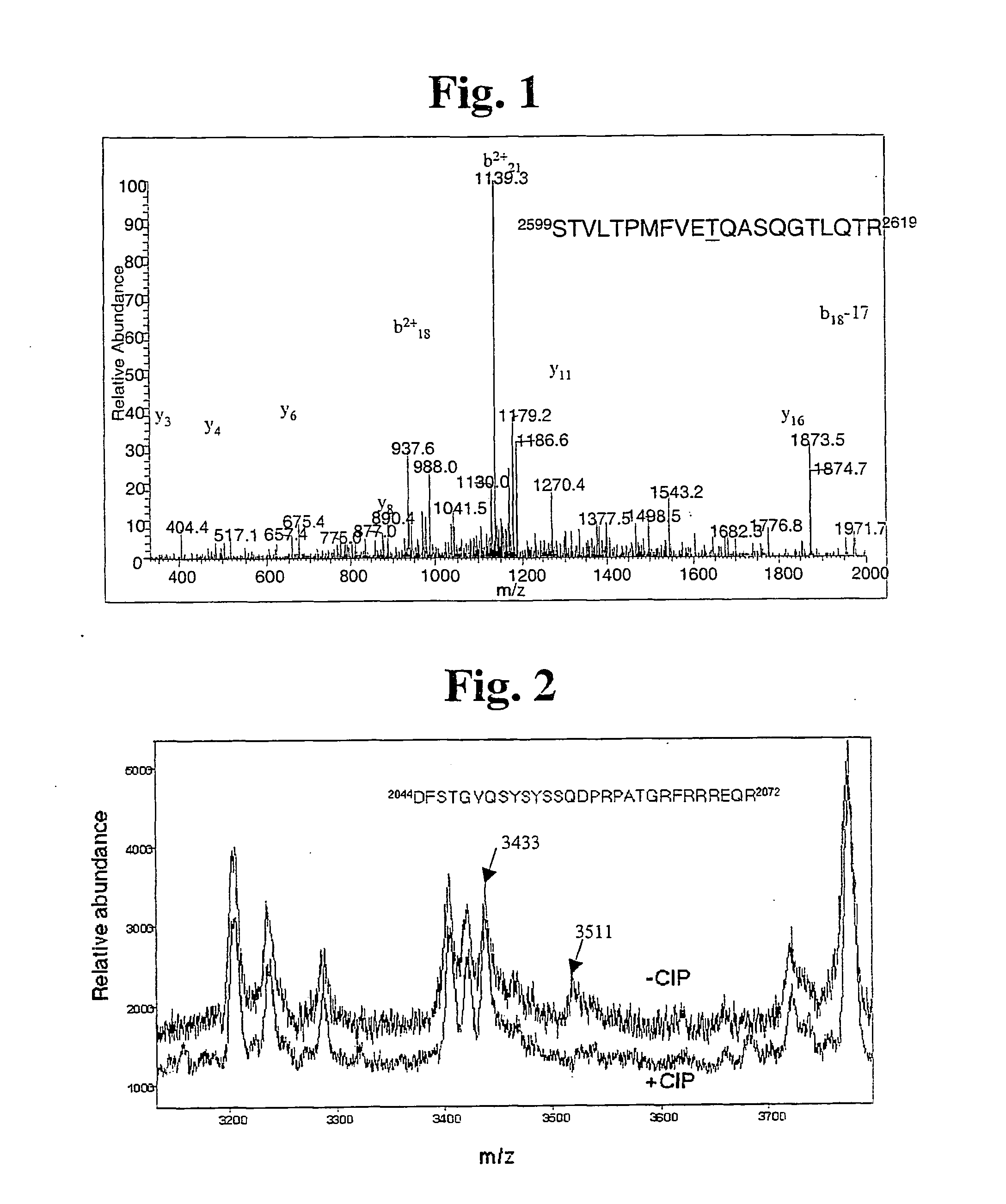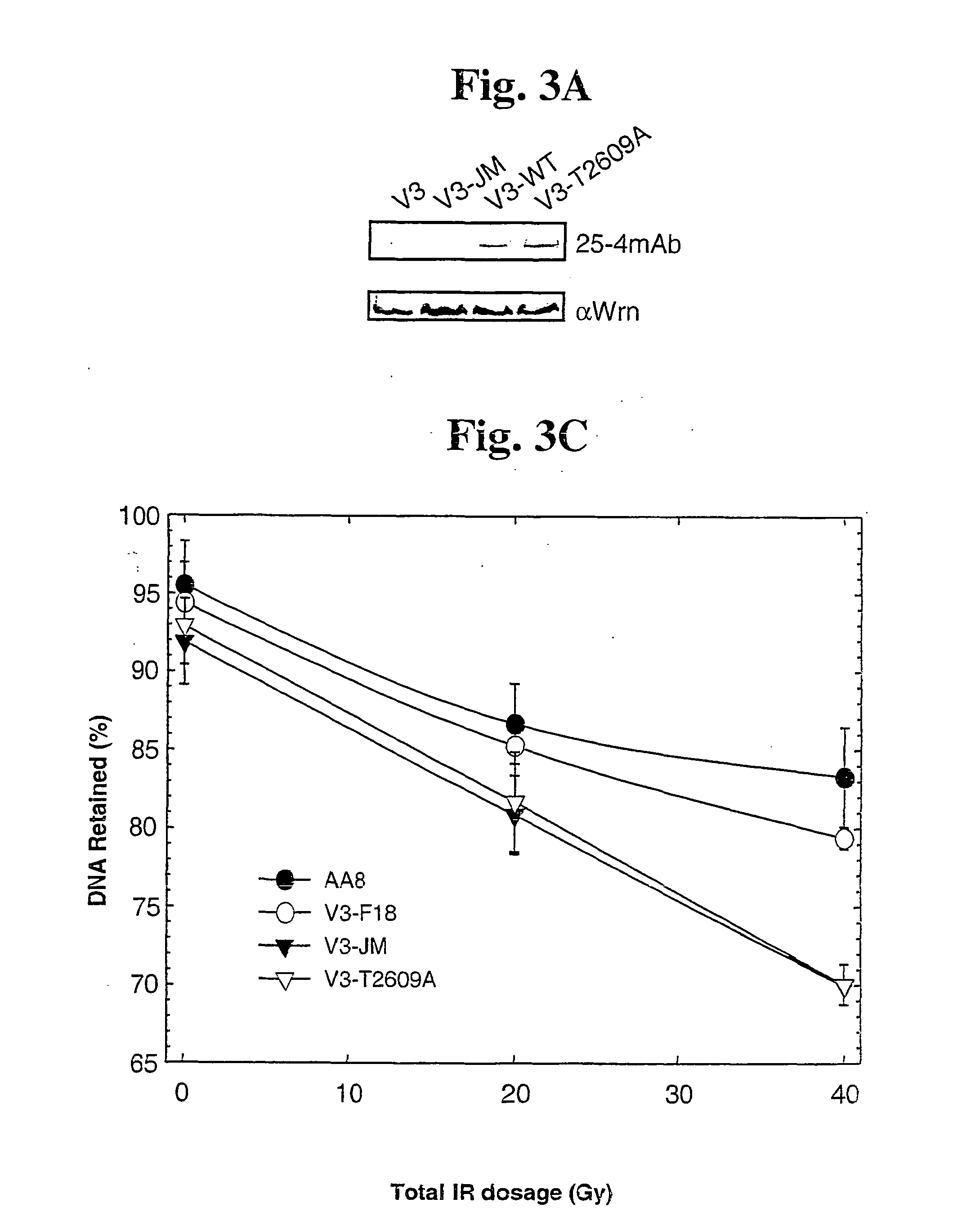Dna dependent protein kinase catalytic subunit phosphorylation sites and antibodies thereto
a kinase and catalytic subunit technology, applied in the field of cancer treatment, therapeutics and diagnostics, can solve the problems of inability to detect, lack of progress in studying physiological functions, and inability to see any discernible foci, so as to improve cell survival
- Summary
- Abstract
- Description
- Claims
- Application Information
AI Technical Summary
Benefits of technology
Problems solved by technology
Method used
Image
Examples
example 1
[0075] Determining T2609 and S2056 Sites of Autophosphorylation in DNA-PKcs by Mass Spectrometry
[0076] First, purified human DNA-PKcs and Ku were autophosphorylated as previously described (Chan and Lees-Miler, J Biol Chem 271: 8936-8941, 1996), and hereby incorporated by reference, with the following change: 50 μM ATP was used instead of 250 μM to allow phosphorylation of the most preferential site. Purified DNA-PKcs and Ku proteins were preincubated at 30° C. Reactions contained 25 mM Hepes, pH 7.5. 75 mM KCl, 10 mM MgCl, 1 mM dithiothreitol, 0.2 mM EDTA, 0.1 mM EDTA plus 10 μg / ml sonicated calf thymus DNA, and 0.25 mM ATP containing stabilized [−P]ATP (Sigma Chemicals, St. Louis, Mo.) (specific activity. 500-1000 dpm / pmol) and were started by the addition of purified DNA-PK proteins (usually 0.05-0.1 μg as indicated). Reactions were at 30° C. for 5-10 min and DNA-PK activity was calculated as nmol of phosphate incorporated into the peptide substrate per minute per milligram of p...
example 2
[0084] DNA-PKcs Fragments and GST Fusion Proteins Containing Autophosphorylated Sites
[0085] 20 bp oligomer primers were designed and ordered from Operon (Alameda, Calif.) using SEQ ID NO: 4 (the nucleotide sequence of DNA-PKcs, GenBank Accession Number: P78527) to created primers to amplify cDNA sequence that encodes the phosphorylation sites, T2609 and S2056. Designed DNA-PKcs cDNA fragments that cover the phosphorylation sites in DNA-PKcs found by mass spectrometer were PCR amplified from the full-length DNA-PKcs cDNA (isolated and described by several of the inventors in Kurimasa et al., Mol Cell Biol 19: 3877-3884, 1999) using the custom designed PCR primers under normal PCR thermal cycling conditions. The reactions were carried out using pfu DNA polymerase (Stratagene, La Jolla, Calif.) and GeneAmp 9600 thermocycler (Perkin Elmer). The amplified cDNA fragments were cloned in frame into GEX-KG vector (Guan & Dixon 1991 Analytical Biochem. 192:262-67) for fusion between domains ...
example 3
[0089] Preparation of Cellular Nuclear Extracts from Cells
[0090] The preparation of nuclear extract from HeLa cells for the Examples that follow were made as generally described by Lees-Miller et al., Mol Cell Biol 10: 6472-6481, 1990 and is herein described. The cells were washed twice with cold PBS, collected, and spun at 2000 g for 5 min. The cell pellet is washed once with 5 ml LSB and spun again. The pellet is resuspended in 1 ml LSB and transfer to a centrifuge tube. (LSB (low salt): 10 mM Hepes pH7.5, 25 mM KCl, 10 mM NaCl. 1 mM MgCl2, 0.1 mM EDTA).
[0091] After spinning down again, the volume of the cell pellet is estimated, then resuspended in 1× Pack cell volume (PCV) of LSB (with 50 mM NaF, 1 mM DTT. 0.5 mM PMSF, and other protease inhibitors), set in ice 5 min, and freezed in liquid N2. Thaw, and spin immediately at 10,000 g for 10 min. Dispose of Supernatant (S10, cytosol fraction.
[0092] The pellet is again resuspended in 1× pack nuclear volume (PNV) of LSB with 0.5M ...
PUM
| Property | Measurement | Unit |
|---|---|---|
| Fraction | aaaaa | aaaaa |
Abstract
Description
Claims
Application Information
 Login to View More
Login to View More - R&D
- Intellectual Property
- Life Sciences
- Materials
- Tech Scout
- Unparalleled Data Quality
- Higher Quality Content
- 60% Fewer Hallucinations
Browse by: Latest US Patents, China's latest patents, Technical Efficacy Thesaurus, Application Domain, Technology Topic, Popular Technical Reports.
© 2025 PatSnap. All rights reserved.Legal|Privacy policy|Modern Slavery Act Transparency Statement|Sitemap|About US| Contact US: help@patsnap.com



